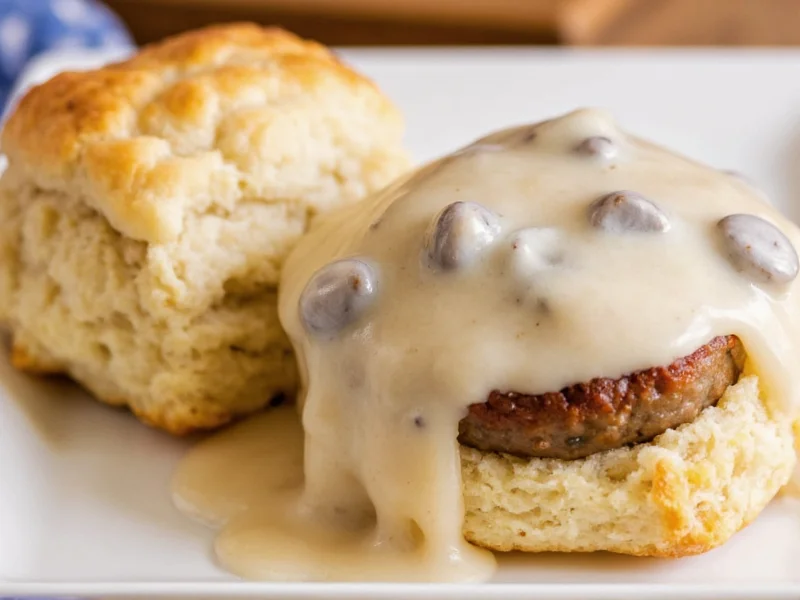The Origins of a Southern Breakfast Staple
Sausage biscuits and gravy traces its roots to 19th century Southern farm kitchens where resourceful cooks transformed basic ingredients into nourishing meals. Before commercial baking powder became widely available, cooks used 'beaten biscuits' - labor-intensive dough pounded to create flakiness. The addition of sausage gravy provided protein and flavor using inexpensive, locally raised pork. This dish became particularly popular among Appalachian and rural Southern communities where hunting and small-scale farming provided the necessary ingredients.
Essential Components of Authentic Sausage Biscuits and Gravy
Creating exceptional sausage biscuits and gravy requires attention to three critical elements: the biscuit texture, sausage quality, and gravy consistency. The perfect biscuit should have distinct layers with a golden exterior and tender interior that holds up to the gravy without becoming soggy. Traditional Southern recipes use white pepper in the gravy for authentic flavor rather than black pepper, which creates visual specks.
| Component | Traditional Approach | Modern Variation |
|---|---|---|
| Biscuits | Hand-cut with knife, minimal handling | Food processor method for consistent texture |
| Sausage | Freshly ground pork with mild seasoning | Turkey or plant-based alternatives |
| Gravy | Whole milk, white pepper, no thickeners | Half-and-half for richer texture |
Step-by-Step Preparation Guide
For the biscuits, combine 2 cups of all-purpose flour, 1 tablespoon baking powder, 1 teaspoon sugar, and 1 teaspoon salt. Cut in 6 tablespoons of very cold unsalted butter until pea-sized crumbs form. Gradually add 3/4 cup cold buttermilk while mixing just until dough comes together. Gently fold the dough 5-6 times on a floured surface before cutting with a 2.5-inch biscuit cutter. Bake at 450°F for 12-15 minutes until golden.
Prepare the gravy while biscuits bake. Cook 1 pound of bulk pork sausage over medium heat until browned but not crisp. Remove 2 tablespoons of drippings to make the roux, returning excess fat to the sausage. Whisk in 1/4 cup all-purpose flour and cook for 2 minutes. Gradually add 2 cups whole milk while whisking constantly. Simmer for 5-7 minutes until thickened, seasoning with 1 teaspoon white pepper and salt to taste.
Perfect Pairings and Serving Techniques
Serve sausage biscuits and gravy immediately after preparation for optimal texture. Split warm biscuits horizontally and ladle generous portions of hot gravy over both halves before reassembling. Traditional Southern breakfast pairings include fried apples, scrambled eggs, and strong black coffee. For contemporary presentations, consider adding a fried egg on top or serving with pickled vegetables to cut through the richness.
Troubleshooting Common Issues
Tough biscuits typically result from overmixing the dough or using warm ingredients. Always keep butter and buttermilk chilled, and handle the dough minimally. If your gravy separates, remove from heat and whisk vigorously while adding a small amount of cold milk. For lumpy gravy, strain through a fine mesh sieve before serving. Gravy that's too thin requires additional simmering time, while overly thick gravy needs gradual milk incorporation.
Storage and Reheating Recommendations
Store components separately for best results. Keep biscuits in an airtight container at room temperature for up to 2 days or freeze for longer storage. Refrigerate gravy in a sealed container for up to 3 days. Reheat gravy gently over low heat with small milk additions to restore consistency. Revive biscuits by warming in a 325°F oven for 5-7 minutes rather than using a microwave, which creates sogginess.
Frequently Asked Questions
What's the difference between sausage gravy and country gravy?
Sausage gravy specifically contains cooked sausage crumbles and their drippings, giving it a distinctive meaty flavor and brown color. Country gravy (or white gravy) is made without meat, typically using just pan drippings, flour, and milk, resulting in a lighter colored sauce often served with chicken fried steak.
Can I make sausage biscuits and gravy ahead of time?
Yes, prepare components separately in advance. Make biscuits up to 2 days ahead and store airtight at room temperature, or freeze for longer storage. Prepare gravy up to 3 days ahead and refrigerate. Reheat gravy gently with additional milk to restore consistency, and warm biscuits in the oven before assembling.
Why does my sausage gravy become thin after sitting?
Gravy naturally thins as it sits due to starch breakdown. To maintain consistency, slightly over-thicken the gravy during preparation. If it thins after sitting, create a slurry with 1 tablespoon cornstarch and 2 tablespoons cold milk, then whisk into simmering gravy until desired thickness returns.
What's the best sausage for authentic biscuits and gravy?
Look for fresh, uncooked pork sausage with mild seasoning (typically 78-80% lean). Avoid pre-cooked or heavily seasoned varieties. Southern butcher shops often carry "breakfast sausage" specifically formulated for gravy with the right fat content (20-22%) to create proper roux without excessive grease.
How do I prevent my biscuits from becoming dense?
Prevent dense biscuits by using cold ingredients, minimal handling (no more than 5-6 folds), and proper cutting technique. Dip your biscuit cutter in flour and press straight down without twisting, which seals the edges and prevents rising. Bake at high heat (450°F) to create maximum steam lift during the initial baking phase.











 浙公网安备
33010002000092号
浙公网安备
33010002000092号 浙B2-20120091-4
浙B2-20120091-4